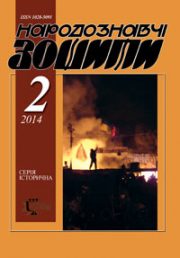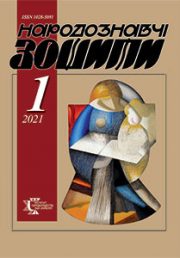The Ethnology Notebooks. 2023. № 4 (172), 1134—
UDK [930.25:39](=161.2:71)
DOI https://doi.org/10.15407/nz2023.04.1134
COLLECTOR OF UKRAINIAN-CANADIAN FOLKLORE JOAN MARGEL
HRYMYCH Maryna
- ORCID ID: https://orcid.org/0000-0001-7028-4879
- PhD (History), professor,
- The Ivan Honchar Museum National Centre of Folk Culture,
- 19, Lavrska str., 01015, Kyiv, Ukraine,
- Contacts: e-mail: hrymych@gmail.com
Abstract. The purpose of the article is to introduce information about the Canadian collector of Ukrainian-Canadian folklore, Joan Margel into scienсe, that is, to reveal a case of collecting practice that is quite rare for Canada, the subject of which is not a professional researcher affiliated with a certain institution, but a private person, an independent collector. Her collecting activities focus on the territory where she spent her childhood and youth – the village (later the town) of Rycroft, located in the so-called Peace River Country (Alberta, Canada). This is the northern limit of the settlement of Ukrainians in Western Canada. Unlike the densely populated area of Ukrainians in East-Central Alberta, this is an understudied region in Canadian Ukrainian studies.
The materials of the amateur researcher are of considerable interest, which shows the relevance of the research. In that area, Ukrainians did not live compactly, but cross-striped, so it has its own cultural local specificity. The object of the research is the collecting activity of Joan Margel, and the subject of the research is various branches of the Ukrainian-Canadian culture of the farming suburbs of the 1920s-1960s, collected through interviews with the so-called old timers and covering such topics as pioneer homesteading and farming, calendar and family rites, customs, old time and blue grass music, etc.
The article was written based on the materials of the Joan Margel Foundation in the Bohdan Medvidsky Archive of Ukrainian Folklore of the University of Alberta (Canada), which is co-organized by the author of the article, as well as based on the materials of other archival collections and an interview with the recorder. The research methodology is based on the complex involvement of various methods, principles and concepts.
Keywords: Joan Margel, folklore collectors, Ukrainian-Canadian folklore.
Received 21.06.2023
REFERENCES
- How do folklorists define folklore. What is Folklore: A Project of the American Folklore Society. Retrieved from:https://whatisfolklore.org/how-folklorists-define-folklore/.
- Pryimak, T. (2020). Yaroslav Bohdan Rudnytskyi and Canada. Istoriohrafichni doslidzhennia v Ukraini 31, 71—77. Retrieved from: http://dspace.nbuv.gov.ua/handle/123456789/182335 [in Ukrainian].
- Klymasz, R.-B., & Hrymych, M. (Ed.). (2013). Ukrainian folk culture in the Canadian prairies. Kyiv: Duliby [in Ukrainian].
- Hrymych, M. (2016). Essays on Ukrainian-Canadian folkloristics: Bohdan Medvidskyi. Kyiv: Duliby [in Ukrainian].
- Andriy Nahachewsky. Curriculum vitae. Retrieved from: https://ualberta.academia.edu/ANahachewsky/CurriculumVitae/.
- Nahachewsky, A. (2007). Kule Centre for Ukrainian and Canadian Folklore. Ethnologies, 29 (1—2), 331—336.
- Foty, N. (2011). Bohdan Medwidsky Ukrainian Folklore Archives of the Peter and Doris Kule Centre for Ukrainian and Canadian Folklore at the University of Alberta. Visnyk of the Lviv University, 10, 253—258. Retrieved from: http://nbuv.gov.ua/UJRN/VLNU_Mistec_2011_10_19 [in Ukrainian].
- Chernyavska, M. (2021). In Between the Worlds: Bohdan Medwidsky Ukrainian Folklore Archives. The Ethnology Notebooks, 6 (162), 1441—1456. DOI https://doi.org/10.15407/nz2021.06.1441 [in Ukrainian].
- Prairie Centre for the study of Ukrainian heritage. Retrieved from: https://pcuh.stmcollege.ca/.
- (2015). Ukrainian Cultural Heritage Village. Official Visitor Guide. Edmonton: Ukrainian Cultural Heritage Village.
- Klymasz, R.-B., & Hrymych, M. (Ed.). (2013). Ukrainian folk culture in the Canadian prairies. Kyiv: Duliby [in Ukrainian].
- Oral History of Sociocultural Change amongst Ukrainian Canadians on the Prairies. Retrieved from: https://pcuh.stmcollege.ca/programs-and-projects/oral-history-initiatives/sociocultural-change/.
- Nahachewsky, A. (2005). Local culture and diversity on the prairies: a project report. Culture locale et diversite dans les prairies: rapport. Edmonton: Friends of the Ukrainian Folklore Centre.
- Bilash, R.-B. (2007). The first Ukrainian settlements in Alberta (Canada): the influence of geographical features of the area on the design of the living space of Ukrainians. Студії з архівної справи та документознавства, 15, 64—70. Retrieved from: http://nbuv.gov.ua/UJRN/sasd_2007_15_11 [in Ukrainian].
- Kononenko N. (2023). Ukrainian Ritual on the Prairies: Growing a Ukrainian Canadian Identity. McGill-Queen’s University Press.
- The Sanctuary Project University of Alberta. Retrieved from: https://livingcultures.ualberta.ca/sanctuary/.
- Bohdan Medwidsky Ukrainian Folklore Archives. Joan Margel collection, 0261.
- (2008, 2010). Maryna Hrymych Private Archive. Canadian collection. Rycroft, 1—4. Interviews by Maryna Hrymych with Joan Margel.
- (2004). Bohdan Medwidsky Ukrainian Folklore Archives. Local Culture collection. Interviews by Serhii Kozakov with Joan Margel, UF 2004-091-0722, UF 2004-091-0729, UF 2004-091-0730, UF 2004-091-0734, UF 2004-091-0754, 2004-091-0778.
- (2010). Maryna Hrymych Private Archive. Canadian collection. Rycroft, 1. Interview by Maryna Hrymych with Joan Margel. 1.04.
- (2004). Bohdan Medwidsky Ukrainian Folklore Archives. Local Culture collection, 1. UF 2004-091-0722. Interview by Serhii Kozakov with Joan Margel. 09.07.
- (2010). Maryna Hrymych Private Archive. Canadian collection. Rycroft, 2. Interview by Maryna Hrymych with Joan Margel. 1.04.
- Meyer A., Witkamp A., Pecoud A. People on the move: Handbook of selected terms and concepts. 2008. UNESCO Digital Library. URL: https://unesdoc.unesco.org/ark:/48223/pf0000163621.
- (1992). New Beginnings. Descendants of Rudeichuk. Reunion 3, 3rd Generation. Introduction by Joan Margel. Wakaw. Saskatchewan.
- Hrymych, M.(2013). Ahatangel Krymskyi and Ivan Lysak: experience of partner cooperation of researcher and respondent. Ukrainian Folk culture: the human life cycle. Historical and ethnological research (Vol. 4, pp. 490—498). Maturity. Men. Male subculture). Kyiv: Duliby.
- N/n. Ukrainian Ethnography News. Vol. 4. 1999.
- (2010). Maryna Hrymych Private Archive. Canadian collection. Rycroft, 4. Interview by Maryna Hrymych with Joan Margel. 1.04.
- Wheatfields and Wildflowers: A History of Rycroft and Surrounding school districts. Rycroft (Alta): Friesen Printers.






